Please check the Part 1 if you have not.
Uprising
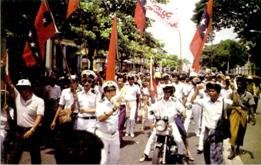
The appointment of Dr. Maung Maung, a civilian head of government, briefly resulted in a subsidence of the shooting and protests. But nationwide demonstrations resumed on 22 August 1988. In Mandalay, 100,000 people protested, including Buddhist monks, 50,000 demonstrated in Sittwe and large marches took places in various cities around Myanmar. Two days later, doctors, monks, musicians, actors, lawyers, army veterans and government office workers joined the protests. During this time, demonstrators became increasingly wary of "suspicious looking" people and police and army officers. On one occasion, a local committee mistakenly beheaded a couple thought to have been carrying a bomb. Incidents like these were happen in other places, where there were no more rule of law and order. Most of the police stations in Yangon was raided by mob. Members of security forces and civilians were killed in outlying areas of the capital. Guns and weapons from raided police stations were distributed among mobs and thugs.
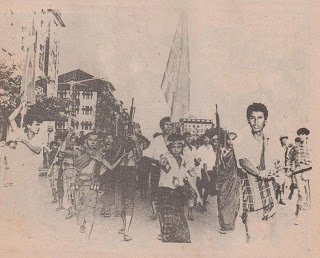
Streets were ruled by Mobs and every male citizens had to armed themselves and defend their neighborhood. Head chopping in public became more frequent. Mobs were accusing suspicious person of being from a military intelligence and beheaded them in public. Most of factories and public buildings in Yangon were sacked and burnt. The government was completely shut down and ruthless mobs violently ruled every city and town and village.
Aung San Su Kyi
On 26 August, Aung San Suu Kyi, who had watched the demonstrations from her mother's bedside, entered the political arena by addressing half a million people at Shwedagon Pagoda.
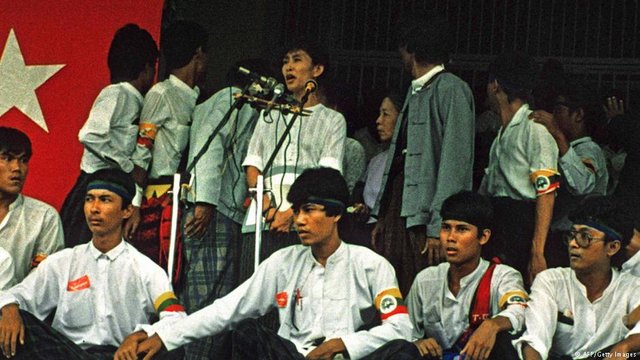
The youngest daughter of General Aung San, Father of the Nation of modern-day Myanmar, Aung San Suu Kyi was born in Rangoon (Yangon), British Burma. Suu Kyi's mother, Khin Kyi, also gained prominence as a political figure in the newly formed Burmese government. Khin Kyi was appointed Burmese ambassador to India and Nepal in 1960, and Aung San Suu Kyi followed her there. Then she continued for her education at St Hugh's College, Oxford. After graduating from University of Oxford in 1968, she worked at the United Nations for three years. Suu Kyi married Dr. Michael Aris, a scholar of Tibetan culture and literature, on 1 January 1972 and living abroad in Bhutan.
Aung San Su Kyi's mother, Daw Khin Kyi, at the age of 76, suffered a severe stroke and she was returned to Myanmar to tend for her ailing mother. On 26 August 1988, she addressed half a million people at a mass rally in front of the Shwedagon Pagoda in the capital, calling for a democratic government. As the daughter of Aung San, who led the independence movement, Aung San Suu Kyi appeared ready to lead the movement for democracy.She urged the crowd not to turn on the army but find peace through non-violent means. Aung San Su Kyi got Nobel Peace Prize in 1990 and used the Prize's 1.3 million USD prize money to establish a health and education trust for the Burmese people.
Around this time, former Prime Minister U Nu and retired Brigadier General Aung Gyi also re-emerged onto the political scene in what was described as a "democracy summer" when many former democracy leaders returned.
End of Uprising and Rise of SLORC
The BSPP announced they would be organizing an election, but the opposition parties called for their immediate resignation from government, allowing an interim government to organize elections. After the BSPP rejected both demands, protesters again took to the streets on 12 September 1988. The police and army began fraternizing with the protesters. The movement had reached an impasse relying on three hopes: daily demonstrations to force the regime to respond to their demands, encouraging soldiers to defect and appealing to an international audience in the hope that United Nations or United States troops would arrive. But only in limited numbers of Myanmar Armed Forces did defect indeed. Stephen Solarz, a United States Congressional Representative from New York, arrived in Burma in September encouraging the regime to reform. By mid-September, the protests grew more violent and lawless, with soldiers deliberately leading protesters into skirmishes that the army easily won. Protesters demanded more immediate change, and distrusted steps for incremental reform.
On 18 September 1988, the military retook power in the country. General Saw Maung repealed the 1974 constitution and established the State Law and Order Restoration Council (SLORC). After imposing martial law, the protests were violently broken up. The government announced on the state-run radio that the military had assumed power in the people's interest. Soldiers went through cities throughout Burma, cracked down the protests and maintained order. It is estimated that within the first week of securing power, 1,000 people were killed and the government described the dead as "looters".
Protesters were also pursued into the jungle and some students took up training on the country's borders with Thailand. It had strengthen the rebel groups along the Government along the border. On 21 September, the government had regained control of the country with the movement effectively collapsing in October. By the end of 1988, it was estimated that 10,000 people – including protesters and soldiers, had been killed. Many others were missing.
"I would like every country in the world to recognize the fact that the people of Burma are being shot down for no reason at all." - Aung San Suu Kyi, 22 September 1988
Aftermath
Many in Myanmar believed that the regime would have collapsed had the United Nations and neighboring countries refused recognition to the coup. Western governments and Japan cut aid to the country. Among Myanmar's neighbors, India was most critical; condemning the suppression, closing borders and setting up refugee camps along its border with Myanmar.
Who fled to the ethnic border areas, formed groups with rebels who wished for greater self-determination in ethnic insurgency area. It was estimated 10,000 had fled to mountains controlled by ethnic insurgents such as the Karen National Liberation Army, and many later trained to become their soldiers.
The National League for Democracy was formed in the aftermath of the 8888 Uprising, led by Daw Aung San Suu Kyi and other political leaders. Suu Kyi had been calling for dialogue between the SLORC and the citizens of Myanmar. In May 1989, the government reopened universities that had been involved in the uprising the previous year. At the same time, the government conceded and a date for the election was set for May 1990 with political parties registering for the election immediately. General elections were held in Myanmar on 27 May 1990 . The elections were won convincingly by Aung San Suu Kyi's National League for Democracy (NLD), who took 392 of the 492 seats. However, the military junta refused to recognise the results, and ruled the country as the State Peace and Development Council until 2011.
Significant
The uprising is remembered and mostly honored by Burmese expatriates and citizens alike. 8888 Uprising is part of Modern Myanmar History which we cannot neglect, whether we like it or not.
The uprising led to the death and imprisonment of thousands of individuals. Many of the deaths were inside the prisons, where prisoners of conscience were subjected to inhumane torture and deprived of basic provisions, such as food, water, medicine, and sanitation. The uprising gave birth to many activists and politician for today Myanmar, also ended life of many. From 1988 up until 2012, the military and police illegally detained and imprisoned tens of thousands of democracy leaders, as well as intellectuals, artists, students, and human rights activists.
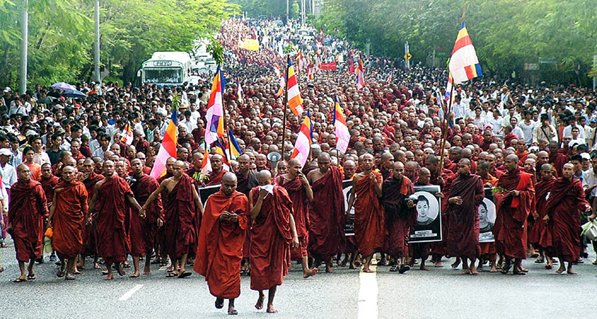
The 88 events gave Myanmar spirit of revolution to coming generations and generations to come. Many of the same activists played a role 19 years later during the 2007 Saffron Revolution.. They were arrested and given lengthy prison sentences of up to 65 years. They were released in a general amnesty in 2012, in period of political reform.
In 2015 Myanmar General Election , the National League for Democracy winning a supermajority of seats in the combined national parliament, and formed a first democratic civilian government in 54 years. Many activists from 8888 uprising were elected as representatives in both houses and secured government positions like Ministers and Chief Ministers. Aung Sann Su Kyi herself was a MP to the House of Representatives from 2012 to 2016, and ascended to the office of State Counselor, which is the de facto head of government of Myanmar, equivalent to a prime minister, in April 2016.
May the uprising failed and it did not bring the democracy it intended for, but the event totally changed the history of Myanmar, and it showed that Myanmar were long for democracy and human rights as it deserved. After 30 years, in 8.8.2018 , NLD and Daw Aung San Su Kyi got political power though under infamous 2008 constitution, Myanmar citizens do not get Democracy they asked for, Human rights they deserved.
The 8888 Uprising is for New generation to remember and to carry on the peace loving democratic spirit and sacrifice for own rights and rights of fellow citizens.
Thanks for reading my long article.
Reference :
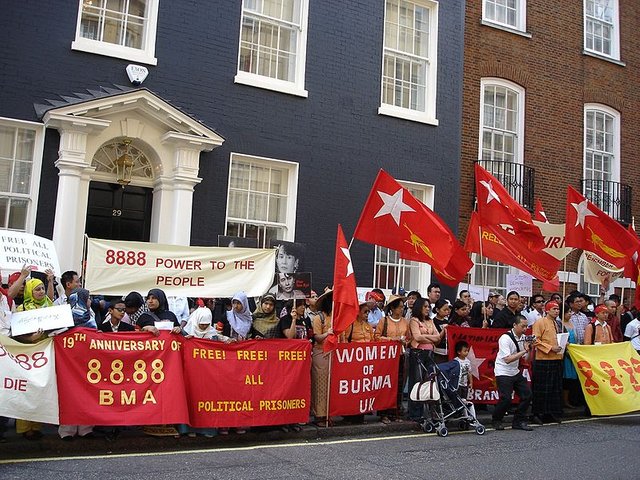
Greetings @new-age-myanmar! Your post was randomly chosen and was resteemed because you are one of our followers. Enjoy your free resteem!
We would appreciate more if you'll take time trying to fit pictures on the right places. You can refer to aligning images on Steemit.
Shareables - We resteem anything we find shareable. Always strive for quality content. Go on express and harness your blogging potential!
God bless from us @Shareables!
Downvoting a post can decrease pending rewards and make it less visible. Common reasons:
Submit